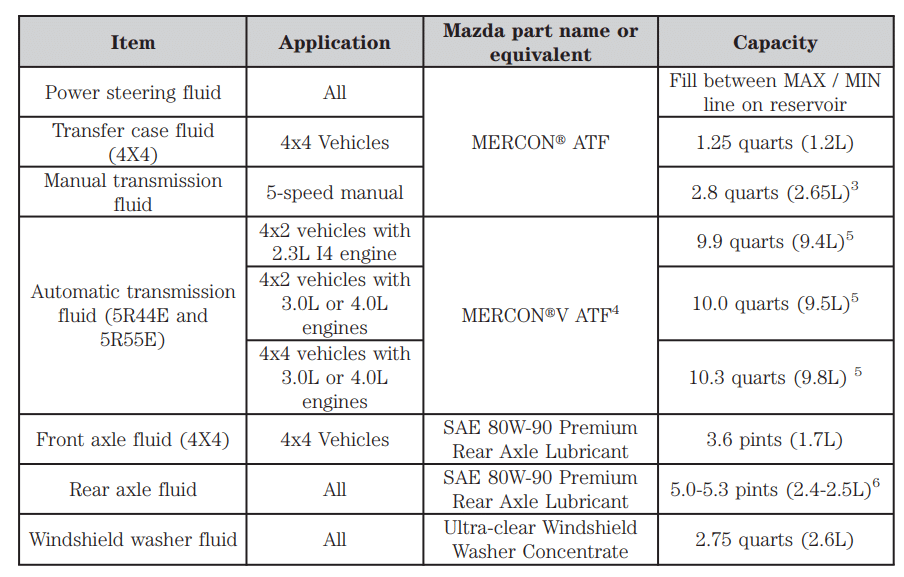In the realm of pickup trucks, the Mazda B-Series stands out as a testament to resilience and reliability. For many years, this robust vehicle has served drivers across various terrains, both in urban settings and rugged landscapes. Its enduring reputation has been cemented by a combination of efficient design, versatile utility, and enduring build quality.
Key Takeaways:
- Right Fluid Type: Always refer to your vehicle’s manual or manufacturer’s recommendation when selecting transmission fluid. Using the wrong type can lead to reduced performance or even damage.
- Capacity Matters: Overfilling or underfilling can adversely affect transmission operations. Knowing the precise fluid capacity for your B-Series model ensures optimal performance.
- Timely Replacement: Adhering to the recommended mileage intervals for fluid changes can prevent wear and tear on your transmission. Regular checks can also help detect potential issues before they become significant problems.
- Costs: While costs can vary between dealerships and local mechanics, it’s essential to view it as an investment in your vehicle’s health. It’s not always about finding the cheapest option, but the most value-driven one.

With its roots tracing back to the 1960s, the B-Series has witnessed numerous evolutions, adapting to the ever-changing demands of the automotive market. Among the notable generations is the 5th, which, in its various facelifts, has proven to be a favorite among enthusiasts and everyday users alike.
As with any vehicle, the vitality of the Mazda B-Series doesn’t solely depend on its engine or chassis but also on the intricate systems working behind the scenes. One such critical system is the transmission, acting as the bridge between the engine’s power and the wheels.
At the heart of this system is the transmission fluid, a seemingly unassuming component that plays an indispensable role.
The fluid serves multiple purposes: it lubricates, cools, cleans, and assists in the gear shifts, ensuring that the transmission operates smoothly. Especially for workhorses like the B-Series, which might often carry heavy loads or traverse challenging terrains, having the right transmission fluid – and ensuring it’s maintained appropriately – is paramount. It directly influences the truck’s performance, fuel efficiency, and longevity.
As B-Series owners or potential buyers, understanding the intricacies of transmission fluid types, capacities, and maintenance requirements is not just a technicality but an essential aspect of vehicle care. This guide aims to shed light on these aspects, ensuring your trusted pickup remains in peak condition.
Understanding Transmission Fluid’s Importance
At its core, transmission fluid is to the transmission system what blood is to the human body. It is the life force that keeps the intricate parts of the transmission well-lubricated, ensuring that they function seamlessly.
Beyond just lubrication, the fluid also aids in cooling the transmission, reducing the risk of overheating especially during intensive activities like towing or navigating hilly terrains.
Furthermore, the fluid acts as a cleaner, picking up and carrying away any debris or contaminants that might have found their way into the system. It also provides the hydraulic pressure needed to facilitate gear shifts, ensuring smooth transitions and minimizing wear.
For trucks like the Mazda B-Series, which are often subjected to more strenuous activities compared to regular passenger vehicles, the importance of transmission fluid cannot be understated.
Whether it’s hauling equipment, towing trailers, or enduring off-road adventures, the B-Series demands a transmission fluid that can rise to the occasion.
Using the incorrect type or quality of fluid, or even operating with less than the recommended capacity, can expose the transmission to undue stress. This could result in reduced performance, decreased fuel efficiency, or, in worst-case scenarios, complete transmission breakdown.
In the B-Series, with its legacy of resilience and performance, ensuring that the right transmission fluid is used and maintained becomes even more critical. It’s not just about keeping the truck running but ensuring it does so optimally, living up to the reputation it has so rightfully earned over the decades.
1995-2009 Mazda B-Series Transmission Fluid Capacity
The Mazda B-Series is renowned for its longevity and toughness, and the right transmission fluid is instrumental in ensuring the vehicle operates at its peak. Here are the recommended fluid types and capacities for the 5th Generation Mazda B-Series and its subsequent facelifts:
5th Gen (1995-1997) Capacities and Types
- Manual Transmission:
- Capacity: 3.3 – 3.6 quarts.
- Recommended Fluid Type: MTF Type A.
5th Gen Facelift (1998-2000) Capacities and Types
- Manual Transmission:
- Capacity: 2.8 quarts.
- Recommended Fluid Type: MTF Type A.
- Automatic Transmission:
- Capacity: Roughly 9.8 quarts for a total flush; a standard drain and fill typically replaces 3.9 quarts.
- Recommended Fluid Type: Mercon/Dexron III ATF.
5th Gen Facelift 2 (2001-2009) Capacities and Types

- Manual Transmission:
- Capacity: Around 2.8 quarts (2.65 liters).
- Recommended Fluid Type: Mercon ATF.
- Automatic Transmission:
- Capacity: 9.9 – 10.3 quarts (9.4 – 9.8 liters)for a complete flush; for a regular drain and fill, you’d typically replace about 5-6 quarts.
- Recommended Fluid Type: Mercon V ATF.
Note: Always remember to cross-reference these recommendations with the owner’s manual or a trusted mechanic. Depending on the exact model, regional differences, and potential updates from the manufacturer, there can sometimes be slight variations in recommendations.
Signs & Timing: When to Replace Transmission Fluid
Maintaining the transmission fluid is crucial for the longevity and optimal performance of the Mazda B-Series. While following manufacturer-recommended mileage intervals is important, sometimes the condition of the vehicle or the environment in which it operates might necessitate earlier fluid changes.
Here’s a guide to help B-Series owners recognize when it’s time to replace the transmission fluid.
Recognizing Mileage Intervals for the B-Series:
- Manual Transmission: Generally, it’s advisable to change the transmission fluid every 30,000 to 60,000 miles. However, if you use your B-Series for heavy-duty tasks like towing, or frequently drive in stop-and-go traffic, consider changing the fluid at the lower end of this range.
- Automatic Transmission: For most automatic transmissions, the fluid should be changed between 60,000 to 100,000 miles. As with manual transmissions, heavy-duty use may require more frequent changes.
Notable Symptoms Indicating a Fluid Change:
- Color Change: Fresh transmission fluid typically has a translucent red hue. Over time, as it degrades, it becomes darker and may even turn brown or black. If the fluid is no longer bright red and translucent, it’s a sign to consider a change.
- Burning Smell: Overheated transmission fluid emits a burnt odor. If you ever detect this smell, it’s a clear indication that the fluid needs replacement, and the transmission should be inspected for potential damage.
- Delayed or Rough Shifting: If the transmission hesitates when shifting gears or if the shifts are more abrupt than usual, it could be due to old or low transmission fluid.
- Grinding or Unusual Noises: Manual transmissions can produce a grinding sound when shifting, while automatics might make unusual noises when in neutral, both indicative of potential transmission fluid issues.
- Gear Slippage: If the transmission unexpectedly changes gears or has difficulty staying in gear, the fluid might be the culprit.
- Surging or Stalling: The transmission may momentarily surge forward or stall for a second due to irregularities in the fluid flow, indicating the need for a change.
- Transmission Fluid Leaks: If you spot red fluid on your garage floor or parking spot, it’s likely a transmission fluid leak, which not only indicates a need to top up the fluid but also to inspect and fix the source of the leak.
Costs: Dealership vs. Local Mechanics
For many vehicle owners, the dilemma of whether to get a service done at a dealership or a local mechanic often comes down to cost, trust, and expertise.
When considering a transmission fluid change for the Mazda B-Series, various factors can influence the final price.
Average Price Breakdown for the B-Series Transmission Fluid Change:
- Dealership:
- Cost Range: $150 – $250
- Dealerships typically charge a premium due to their specialized knowledge, original equipment manufacturer (OEM) parts, and association with the brand. While you might pay more, you can also expect high-quality service, warranty on the work, and peace of mind knowing that technicians have brand-specific training.
- Local Mechanics:
- Cost Range: $80 – $150
- Local mechanics, especially those who aren’t brand-specific, generally have lower overhead costs, which can result in more affordable services. The expertise might vary, so it’s essential to choose a reputable mechanic. Often, they can offer more personalized services and might be more flexible in terms of scheduling and pricing.
Cost Variables and Influencing Factors:
- Location: Prices can vary significantly depending on your location. Urban areas, with higher living costs, might see elevated service prices compared to rural regions.
- Type of Transmission: Automatic transmissions may sometimes have a slightly higher service cost due to the complexity of the system.
- Fluid Type and Quantity: OEM fluids, typically used by dealerships, might be more expensive than aftermarket options. The cost can also vary depending on the amount of fluid required for the change.
- Additional Services: Sometimes, a simple fluid change might come with additional services or checks, like a transmission filter replacement or a system inspection, which can add to the cost.
- Labor Costs: This is often the most significant cost variable. Dealerships might have a higher hourly rate compared to local mechanics.
- Promotions and Discounts: Dealerships might offer promotions, especially if you’re a regular customer or have purchased your vehicle from them. On the other hand, local mechanics might provide discounts for referrals or repeat business.
















